In August of 2002, during the ceremony making the contract award for the Integrated Deepwater System, (IDS), Coast Guard Commandant Admiral Thomas H. Collins described the critical need to upgrade and modernize the service’s force of cutters, aerial platforms, and support systems. He stressed that the Coast Guard must have the most capable ships, aircraft, and command-and-control technology available to protect our nation and carry out our many missions.
With the contract awarded to Integrated Coast Guard Systems (ICGS)—a joint venture between Northrop Grumman and Lockheed Martin—the plan to implement the transformation of Coast Guard aviation was set in motion. It encompassed the progressive upgrading of selected legacy assets and the introduction of new and more capable fixed-wing aircraft, helicopters, and unmanned aerial vehicles (UAVs).
The transformation of Coast Guard aviation assets was aimed at creating major improvements to system-level operational effectiveness at an affordable cost. Given the Coast Guard’s operational tempo since the attacks of 11 September 2001—and the overall material condition of all aircraft—the need to transform its aviation assets had never been more compelling. The Coast Guard’s aging force of aerial assets faced increased operational demands, spiraling maintenance costs, and less than optimum operational effectiveness in a number of areas. The addition of high priority homeland security and national defense missions superimposed on existing law enforcement and search and rescue responsibilities made this situation especially critical. Fortunately; a much-needed infusion of additional funding for operations and maintenance during the two year period prior to the IGCS contract restored the readiness rates for all aircraft systems to stable levels. Upgrades to aircraft sensors improved operational capabilities in a number of areas, but shortfalls still existed in fielding secure, fully interoperable communications and data-exchange systems.
The Coast Guard’s aviation units accumulate flying hours on airframes, aircraft engines, and components more quickly than their counterparts in sister services. These hours accelerate the impact of wear and tear, raise safety-of-flight issues in some areas, and require the replacement of “high-time” components more frequently. In 2003 the average age of the Coast Guard’s fixed-wing inventory was 20 years, and its rotary-wing fleet averaged 16 years for the HH-65 Dolphin and 11 years for the HH-60 Jayhawk. The Coast Guard’s maintenance-support budget grew at just 2% per year at a time when its documented operating and maintenance costs rose by 7-11% per year. Aware of continuing cost escalation and the approaching block obsolescence of legacy platforms the Deepwater’s system-of-systems approach for recapitalization was determined, at the time of inception, to be the only feasible and affordable option to sustain the Coast Guard’s aviation excellence well into the 21st century.
Deepwater was designed to provide a mix of upgraded legacy assets and new aerial platforms to be phased into operational service. All aircraft, helicopters, have been outfitted with improved radars and sensors for night and all-weather operations. Interoperable communication and data-exchange systems are incorporated to improve the capabilities needed for joint, multi-agency operations and the development of maritime domain awareness and a common operating picture. Initial requirements were modified to address additional mission requirements upon transfer of the Coast Guard to the Department of Homeland Security March 1, 2003.
Legacy aviation assets that were expensive to operate and maintain were scheduled to be replaced as soon possible. In the interim they were upgraded with improved communication, command and control, and sensor capabilities (C4ISR). The HU-25 Guardian medium-range search-and-rescue/interdiction turbojet was replaced by the EADS-CASA medium range HC-144A maritime patrol aircraft (MPA).
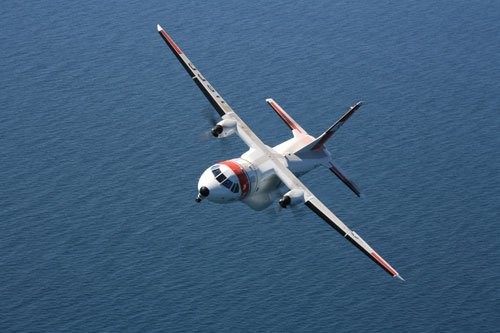
This fixed-wing turboprop aircraft provides increased on-scene loitering capabilities and performs various missions including maritime patrol, law enforcement, cargo and personnel transport and Search and Rescue. The first of a proposed 36 HC-144 arrived on board December 21, 2007. The aircraft is fully interoperable with other Integrated Deepwater System platforms and shares a common mission systems pallet with the HC-130s. The HC-144 has multiple voice and data communications capabilities, including UHF/VHF, HF, and Commercial Satellite Communications. The aircraft is equipped with state-of-the-art search radar, an Electro-Optical Infra-red system and electronic surveillance measures. Powered by two General Electric CT7-0C3 turboprop engines, the aircraft has a maximum cruising speed of 236 knots, a maximum range of 1,565 nautical miles and when configured for MPA missions, an endurance of 8.7 s. It was the first all-new aircraft to enter into the Coast Guard inventory under the Deepwater program.
Under Deepwater the number of HC-130H search-and-surveillance aircraft was scheduled to be reduced to 16. These HC-130H aircraft were to receive a new center wing box frame and programmed depot maintenance. They will be further upgraded with improved command-and-control capabilities to ensure full interoperability with other Integrated Deepwater System platforms. Upon completion of upgrade the service life would be extended to 2027. There were 22 HC-130H aircraft retained. These aircraft were augmented by six C-130J aircraft obtaining by supplemental funding. In 2014 an agreement was entered into whereby seven C-130H aircraft would be upgraded by DOD and given to the Forrest Service in exchange for 14 C-27J DOD aircraft. Continued purchase of the HC-144 has been suspended.
*note: Information on the HC-27J may be obtained under “2014 -Coast Guard Acquires C-27J “
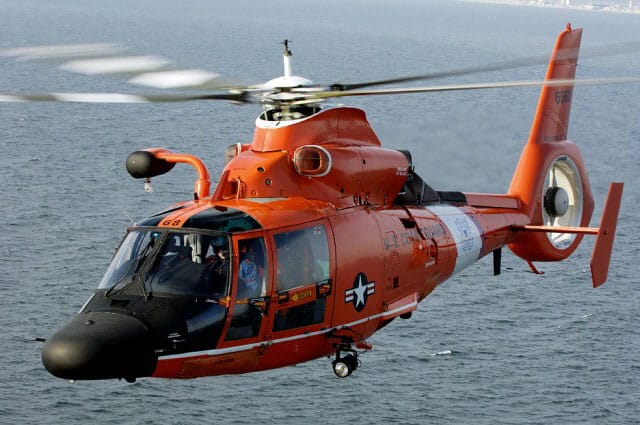
There were 95 HH-65 airframes in the 2002 inventory and due to its composite construction, unlike other Coast Guard platforms; it has no airframe service life. As a result it was decided to invest in the fleet of HH-65s with a Service Life Extension Plan (SLEP) that would yield a like-new aircraft as the Multi-Mission Cutter Helicopter. The upgrade was scheduled in phases. An Avionics retrofit had been undertaken in 2001. It consisted of a Night Vision Goggle (NVG) compatible integrated flight management avionics suite consisting of two GPS-embedded CDU-900G control display units and two MFD-255 multifunction flat panel displays.
Since its introduction in 1984, the HH65, powered by the LTS101-750 engine, experienced a variety of engine problems. The problem initially was with the core engine and in the 2003-2004 time period the number of reported power losses and incidents, primarily due to faults within the fuel governing system, had grown dramatically. In fiscal 2003 pilots had reported 32 incidents and in the 7 month period from October 2003 to 1 March 2004, there were 67 incidents reported.
The degraded safety and reliability of the HH-65A/B powerplant forced the Coast Guard to make improvement of the powerplant the number one priority of Coast Guard Aviation. Time critical, a decision had been made by aviation forces to initiate a prototype reenginining project utilizing Turbomeca Arriel 2C-1/2 engines, on Coast Guard HH-65 #6560 at the Coast Guard’s Aircraft Repair and Supply Center in Elizabeth City, NC. The engine had been proven on the Eurocopter EC 155 and could be installed on the HH-65 with no structural adaptation. An HH-65 was flown with Arriel 2C2 engines in the summer of 2003 and it proved to be an excellent match. Subsequent testing and evaluation identified this engine as a solution to the HH-65A/B engine failure/power decrease problem.
The aviation forces prevailed. The engine change would remain in the ICGS program. However, American Eurocopter provided 2C2 re-engineering kits and the engine changes were performed by AR&SC on an expedited schedule, at reduced cost, and sustained high quality workmanship was obtained. To expedite the schedule engine replacement 16 aircraft were re-engined at the new American Eurocopter facility in Columbus Mississippi.
The upgrade to HH-65C included the installation of a 10 blade low-noise Fenestron, relocated avionics and an Airborne Use of Force (AUF). In early 2008 the HH-65C replaced the Agusta MH-68A as the aircraft used by the Coast Guard Helicopter Interdiction Squadron (HITRON).
In 2011 the aircraft was again upgraded and designated MH-65D. It was fitted with a radar altimeter, two imbedded GPS inertial navigation systems and two control display units.
The Bell-Augusta Aerospace AB-139 Recovery and Surveillance (VRS) helicopter was selected by Integrated Coast Guard Systems (ICGS) to replace the HH-60J Jayhawk as the medium-range recovery and surveillance helicopter. This state-of-the-art, twin-engine helicopter was designed to meet the unique demands of high-risk operating environments. Delivery was planned between 2014 and 2022. The AB-139 was smaller than the HH-60J and was determined to be unsuitable to meet Homeland Security Airborne Use of Force and Vertical Insertion/Vertical Delivery mission requirements. It was decided to upgrade the HH-60J to meet mission requirements.
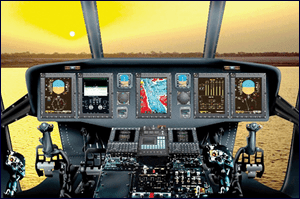
The MH-60T Medium Range Recovery Helicopter upgrade program began in 2007. All H-60J airframes were upgraded with a General Electric T700 power plant. The electronics upgrade consists of a Rockwell Collins Common Avionics Architecture System (CAAS). CAAS is an integrated “glass” cockpit which provides updated avionics and integrated Electro-optical Sensor System with recording capability via a removable memory module. CAAS also replaces legacy radios with the AN/ARC 210, ARC 220 and the RT-5000/SAR radios. Four MH-60 units Maintain Airborne Use of Force (AUF) and all of the MH-60s are AUF equipped. The MH-60T has an Airborne Use of Force package capable of both warning and disabling shots as well as crew protection from small arms fire. The MH-60T also has a Vertical Insertion and Vertical Delivery capability.
Deepwater’s aviation plan also called for the Coast Guard to introduce its first UAVs into the inventory by mid-
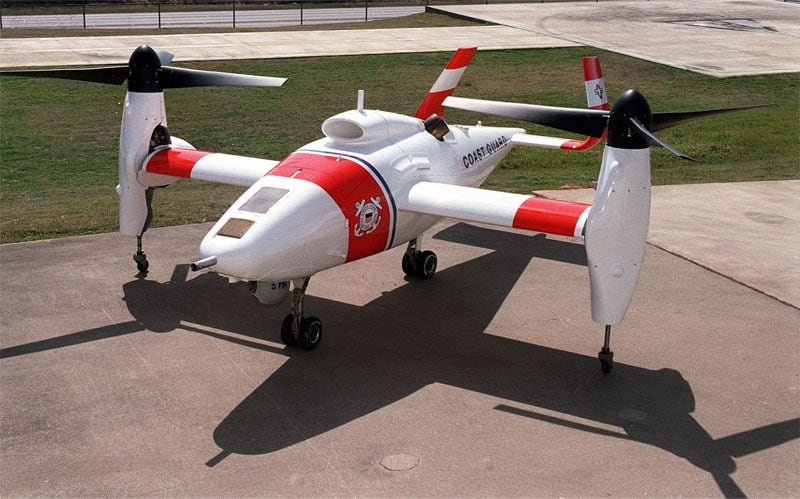
decade. Bell Helicopter was awarded a contract to commence concept and preliminary design work on the HV-911 Eagle Eye vertical take-off and landing unmanned aerial vehicle. Prototypes were developed and built for testing in 2005. The Coast Guard had planned to purchase 69 Eagle Eyes if the aircraft met requirement. It was desired to deploy VUAVs on board new-construction offshore patrol cutters and national security cutters as well as on Bear (WMEC-901)-class medium-endurance legacy cutters. The VUAV’s initial operational capability, projected for 2006, was timed for the delivery of the first national security cutter.
The Coast Guard cancelled the Bell HV-911 contract in March 2008 because it did not meet performance requirements.
As a result the UAS acquisition program became focused on technologically mature systems with commonality with Department Of Homeland Security and Department of Defense programs. A letter of interest was sent to the U.S. Navy to begin testing the RQ-8A Fire Scout unmanned helicopter for Coast Guard operations. The Navy program experienced a funding reduction and a long development period. Coast Guard participation Took place but the Navy Program is proceeding slowly.
Future planning called for the lease of four modified RQ-4 Global Hawk HAE UAVs. The Global Hawk was selected to fulfill the anticipated requirement for a high-altitude, long-endurance land based UAV. There has been no capital investment to date. By 2012 the U.S. Air Force wanted to discontinue the RQ-4 in favor of the upgraded U-2.
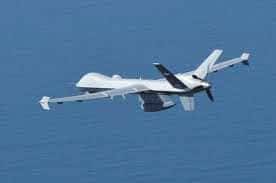
In November 2008 the CPB and the USCG formed a UAS Joint Program Office (JPO) to jointly operate a maritime version of the Predator-B and identify common maritime UAS requirements, including sensors, command and control, data exploitation, logistics and training, and basing. This collaboration proved to be extremely successful. CBP pilots, augmented by USCG personnel, use the Guardian to conduct long-range surveillance in support of joint counter-narcotics operations in the southeast coastal and Gulf of Mexico border regions and drug source and transit zones, where maritime radar is necessary to detect a variety of threats. The Guardian is a strategic asset for homeland security operated at and beyond the Nation’s borders to overcome threats moving towards the United States.
Cutter-based UAS are considered part of the total ‘force package’ for the service’s major cutters, including the National Security Cutter (NSC) and planned Offshore Patrol Cutter. Unmanned Aircraft System’s (UAS) have the potential to provide the Coast Guard’s National Security Cutters (NSC) with a persistent and efficient surveillance tool. The Coast Guard’s Research and Development Center has conducted two at-sea ScanEagle UAS demonstrations and evaluations aboard National Security Cutters. The small UAS (sUAS) for National Security Cutters (NSC) project is currently in the Analyze/Select phase. The current plan is to start off with a simple, low risk system to get the initial flight deck and aviation facility certifications, conduct flight operations and use that to build more elaborate systems.
The Coast Guard realized that they needed a long term strategy to recapitalize its inventory of cutters, aircraft and support systems. Deepwater was a unique system-of-systems approach to fulfill this requirement. Execution became a significant problem. The Coast Guard set the performance requirements for the program but allowed the contractor, ICGS, to assume responsibility for designing, building and integrating the systems. Oversight by the Coast Guard was minimal and in general expertise of Coast Guard personnel was considered secondary to that of private contractors.
Aviation forces fared better than surface forces under Deepwater because there was a deliberate effort on their part to monitor, evaluate, suggest and make their opinions and conclusions known to Integrated Deepwater System Program (IDS) managers. The HH-65C engine replacement is atypical of actions taken by the Aviation Aeronautical Community.
Captain “Jake” Korn, well qualified in all aspects, led three study groups on the future of Coast Guard Aviation, which set the near term strategic direction for the Coast Guard’s aviation fleet. The first dealt with the requisites to enable the Fixed Wing fleet to meet all the CG’s requirements. The second dealt with the requisites to enable the Rotary Wing fleet to meet all the CG’s requirements. The third identified what was needed to make the then-current (2004) Aviation fleet last another 20 years in case the Deepwater Program proved not to be successful. Captain Thomas C. King, Chief Aviations Forces, used results of these studies and inputs From Captain Barry Harner, Chief of Aviation Engineering, as a basis in his attempts to effectively deliver the capabilities needed to execute the full range of missions. Of utmost importance were the efforts of RADM Dave Belz, the Assistant to the Commandant for Operations with responsibilities that included oversight of a wide range of Coast Guard missions. On numerous occasions he forcefully and effectively presented the views of the Aviation Forces.
In 2007 the Coast Guard replaced the single integrated Deepwater acquisition program with an Acquisition Directorate that retained a systems outlook by employing Coast Guard program managers who have purview over a portfolio of related projects within their domains.
(See: 2002 – Initial Contracts for deepwater Project Awarded: for further information)
In 2012 use of the term Deepwater was discontinued.
